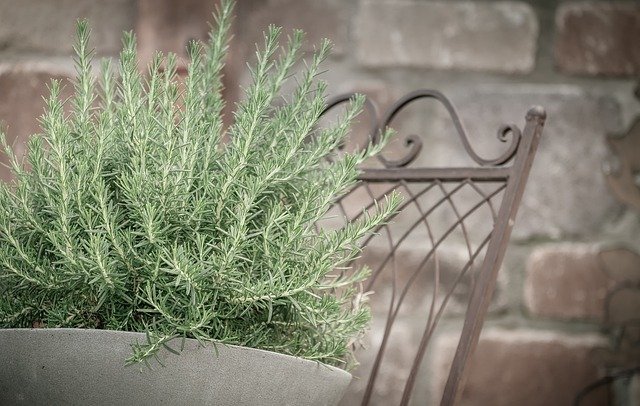There are many types of plants in the world, each with its unique features. One type of plant that is becoming increasingly popular is the variegated trailing plant. This type of plant has leaves that are brightly colored and patterned, making them a beautiful addition to any garden or landscape.
So, what exactly is a variegated trailing plant? Variegated plants are those that have leaves of two or more colors. The colors can be very different, such as white and green, or similar, such as shades of green.
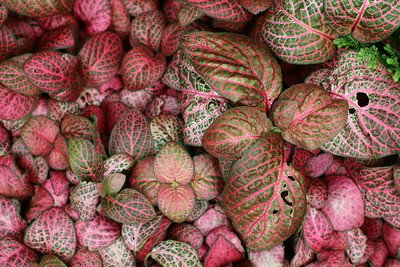
Trailing plants are those that have stems that trail down instead of standing up straight. This can give the plant a cascading or waterfall-like appearance. Variegated trailing plants are simply those that have both of these characteristics: variegated leaves and a trailing habit.
There are many benefits to growing variegated trailing plants. For one, they add interest and beauty to any garden or landscape. The bright colors and patterns of the leaves can really make a space pop.
Additionally, variegated plants are often more resistant to pests and diseases than other types of plants. This is because the different colors of the leaves confuse pests, making it difficult for them to find and eat the plant.
If you’re interested in growing variegated trailing plants, here are ten examples of beautiful plants that fit this description:
Table of Contents
Ivy (Hedera sp.)
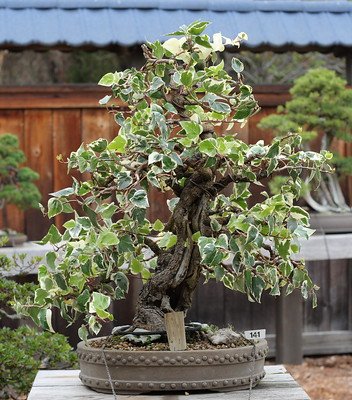
Ivy (Hedera sp.) is a trailing or climbing evergreen plant that is a member of the Araliaceae, or ginseng, family. It is native to Europe, Asia, and Africa and has been introduced to North America and Australia.
Ivy typically has dark-green, glossy leaves, but there are also variegated varieties with white or yellow markings. The leaves are simple, alternate, and ovate to heart-shaped. The stems of ivy can grow up to 50 feet long and often take on a woody texture as the plant matures.
Ivy can be grown indoors or outdoors and does best in moist, well-drained soil that is rich in organic matter. It prefers partial to full shade but can tolerate some sun. When grown indoors, ivy needs bright light but should be protected from direct sunlight.
It is important to keep the soil evenly moist but not soggy. Ivy can be propagated from stem cuttings taken in late spring or early summer.
Pothos (Epipremnum aureum)

Pothos (Epipremnum aureum) is a trailing plant that can grow up to 20 feet long. It has variegated leaves that are green and white in color. The plant is native to the Solomon Islands, but it can be found in other parts of the world.
Pothos is an evergreen plant, meaning it will retain its leaves all year round. The plant prefers warm climates and does not tolerate frost. Pothos can be grown indoors or outdoors, but it is best suited for growing outdoors in a shady area.
The plant does not require much maintenance, but it should be watered regularly. Pothos is a fast-growing plant, so it is best to prune it regularly to prevent it from taking over an area.
Tradescantia zebrina

Tradescantia zebrina, more commonly known as Zebrinas, are beautiful trailing plants that are native to Central and South America. They are easily distinguished by their striking variegated leaves, which are usually green and white or purple and white.
Zebrinas can grow to be quite long, up to 3 feet in length, and do best when allowed to trail over the edge of a pot or hanging basket. Although they can tolerate low light conditions, they prefer bright indirect light and will thrive when given plenty of opportunities to climb.
Because of their trailing habit, Zebrinas make great houseplants; however, they can also be grown outdoors in warm climates. Overall, Zebrinas are easy-care plants that make a beautiful addition to any home.
Chlorophytum comosum ‘Variegatum’

Chlorophytum comosum ‘Variegatum’, more commonly known as Spider Plant, is a popular trailing plant that is characterized by its variegated leaves. The leaves are long and narrow, with white stripes running along the length of the leaf.
The plant can grow to be up to 2 feet tall and 3 feet wide, making it an ideal candidate for both indoor and outdoor growth. When grown outdoors, Spider Plant should be kept in a location that receives partial sun to full shade.
If grown indoors, Spider Plant prefers bright, indirect light but can also tolerate low-light conditions. While the plant is relatively drought tolerant, it will benefit from being watered on a weekly basis. With proper care, Spider Plant can make an excellent addition to any home or garden.
Saxifraga stolonifera

Saxifraga stolonifera, also known as strawberry begonia, is a trailing plant that typically grows to be about 6-12 inches tall. This plant is characterized by its smaller, round leaves that are variegated with white and green colors.
Saxifraga stolonifera can be grown both indoors and outdoors, although it prefers cooler temperatures and shade locations. When grown outdoors, this plant can tolerate Partial sun to shade and well-drained soils. When grown indoors, Saxifraga stolonifera should be placed in an east or north-facing window.
This plant does not require a lot of maintenance and can be left to grow on its own. However, it is important to water this plant regularly as it is susceptible to root rot. Overall, Saxifraga stolonifera is a low-maintenance plant that can add texture and color to any space.
Begonia boliviensis
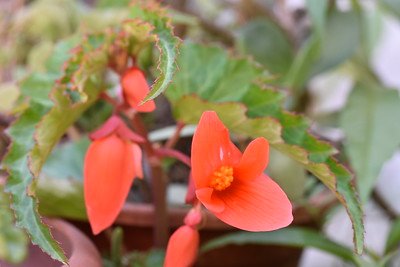
Begonia boliviensis, also known as Bolivian begonia or trailing begonia, is a popular houseplant that is known for its vibrant colors and easy care. The plant can be either trailing or upright, and its leaves are typically variegated with shades of green, pink, and white.
Begonia boliviensis can grow to be quite large, reaching up to 10 feet in length. When grown indoors, the plant will usually remain smaller, only reaching a few feet in height. Regardless of its size, Begonia boliviensis is a relatively low-maintenance plant that does not require much care. It prefers indirect sunlight and moist soil, but it is tolerant of lower light levels and can even tolerate some shade.
Begonia boliviensis is also fairly tolerant of drought conditions. While the plant can be grown outdoors in warmer climates, it is best suited for indoor growth in most regions. Overall, Begonia boliviensis is a versatile and vibrant plant that makes a beautiful addition to any home.
Fittonia albivenis

The Fittonia albivenis is a trailing plant that is typically grown indoors. It has variegated leaves, which means that the leaves are two different colors.
The plant can grow to be up to 18 inches tall and 24 inches long. It prefers to grow in indirect sunlight and in humid environments. When grown outdoors, the plant can tolerate full sun but is more likely to suffer from sunburns.
The plant is also susceptible to spider mites and mealybugs. Overall, the Fittonia albivenis is a low-maintenance plant that makes a beautiful addition to any indoor space.
Senecio rowleyanus
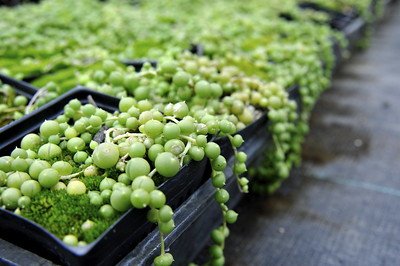
Senecio rowleyanusa, more commonly known as String of pearls, is a succulent plant that is typically grown as a houseplant. The plant is native to South Africa and Namibia, and it gets its name from its small, round leaves which resemble pearls.
A string of pearls can trail up to 3 feet in length, and its leaves can range in color from green to shades of pink, purple, and white. While the plant can be grown outdoors in warm climates, it is typically grown indoors as a houseplant.
When growing Senecio rowleyanusa indoors, it is important to provide bright light and well-draining soil. The plant is relatively easy to care for and can tolerate periods of neglect. However, it is important to avoid overwatering, as this can cause the plant to rot. With proper care, Senecio rowleyanusa can thrive indoors or outdoors and make an attractive addition to any home or garden.
Solanum jasminoides ‘Variegatum’
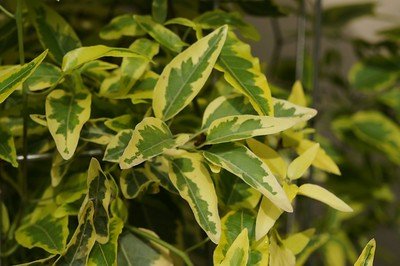
Solanum jasminoides, commonly known as potato vine or nightshade, is a fast-growing evergreen climber native to Brazil. A member of the Solanaceae family, it is related to tomato, pepper, and eggplant.
S. jasminoides is a trailing or scrambling plant with ovate to heart-shaped leaves that are variegated with shades of green and cream. Clusters of small white flowers bloom throughout the summer.
The potato vine can reach a length of 30 feet (9 meters) or more if left unchecked, making it an ideal plant for covering a fence or trellis. It can also be trained as a free-standing bush or standard.
While S. jasminoides is most often grown outdoors in USDA hardiness zones 10-11, it can be grown indoors as a houseplant in cooler climates. Provide bright, indirect light and well-drained soil for best results.
Peperomia prostrata

Peperomia prostrata is a trailing plant that is native to South America. It has variegated leaves and can grow up to 12 inches tall and 18 inches long. This plant prefers to grow in indirect sunlight and does best when grown indoors.
However, it can also be grown outdoors in shady areas. Peperomia prostrata is a low-maintenance plant that does not require much watering. It is also resistant to pests and disease. This plant makes an excellent addition to any indoor or outdoor garden.
As you can see, there are many different types of variegated trailing plants to choose from. Whether you’re looking for a plant with bold colors or more subtle shades, there’s sure to be a plant on this list that will suit your needs. So what are you waiting for? Get out there and start growing some beautiful variegated trailing plants!

Gardening is my passion and growing plants indoors has always been a stress relief for me. Grow a banana tree in my apartment once (although failed to produce bananas).





